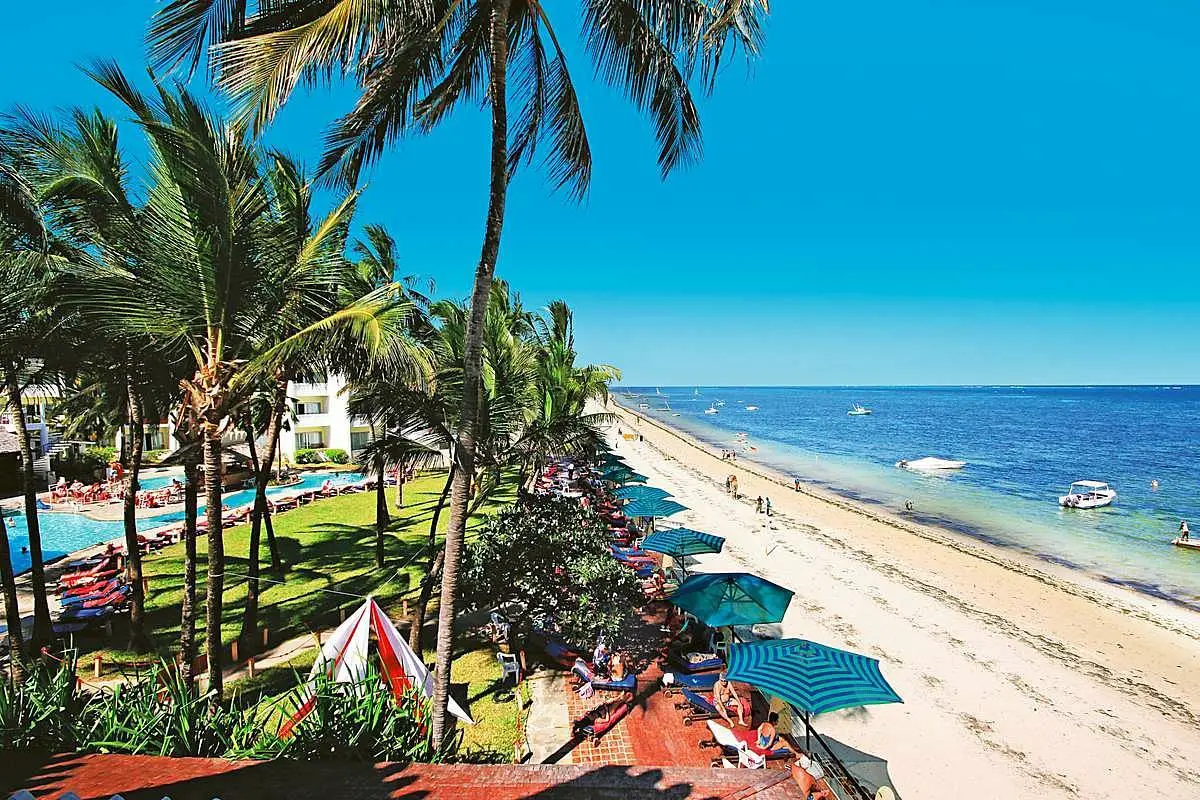As Kenya’s second-largest city, Mombasa exudes a charm that is both raw and refined. Situated on the country’s southeast coast, this ancient port city is rich with history and vibrant in culture, making it a captivating destination for travelers worldwide.
With its pristine beaches, fascinating historical sites, diverse marine life, and colorful markets, Mombasa provides a unique cultural experience that is as enriching as it is entertaining.
Fort Jesus
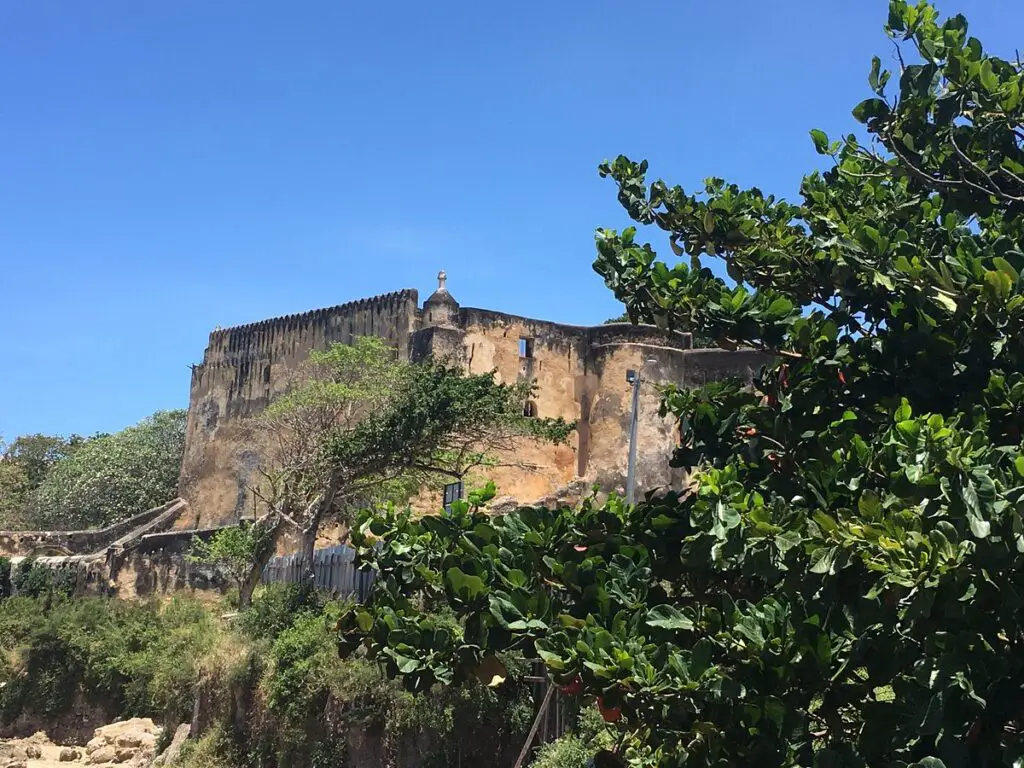
Located on Mombasa Island, Fort Jesus is a UNESCO World Heritage Site and one of Mombasa’s most visited tourist attractions. The fort was designed by an Italian architect and military engineer, Giovanni Battista Cairati, and built by the Portuguese in 1593. The fort was constructed to secure the safety of Portuguese living on the East Coast of Africa, and it has lived through the centuries as a silent witness to the interchange of cultural and military influences between Europe, Asia, and Africa.
Fort Jesus showcases a unique masterpiece of late Renaissance military fortification. It’s a stellar example of a type of fortification that Portuguese military engineers replicated in many parts of their world during the 16th and 17th centuries. Its layout is roughly rectangular, and it consists of four bulwarks at its corners. The fort quickly became a vital stopover for ships sailing the spice route and played a critical role in the route’s control.
Over the centuries, the fort changed hands numerous times, among the Portuguese, Omani Arabs, and the British. Each era left its mark, contributing to the fort’s rich history. Today, the fort houses a museum that displays various artifacts from the era of Swahili culture and the slave trade, along with archaeological findings from the coastal region of Kenya. These include porcelain, pottery, and utensils from the Ming dynasty, signifying Chinese contact, which is a testimony to the historical and cultural interchange between different civilizations.
The fort offers beautiful views of the Indian Ocean, and the sound-and-light show, which brings the fort’s tumultuous history to life, is a must-see for visitors. With its deep historical significance and picturesque location, Fort Jesus offers visitors a unique journey into Mombasa’s past.
Old Town Mombasa
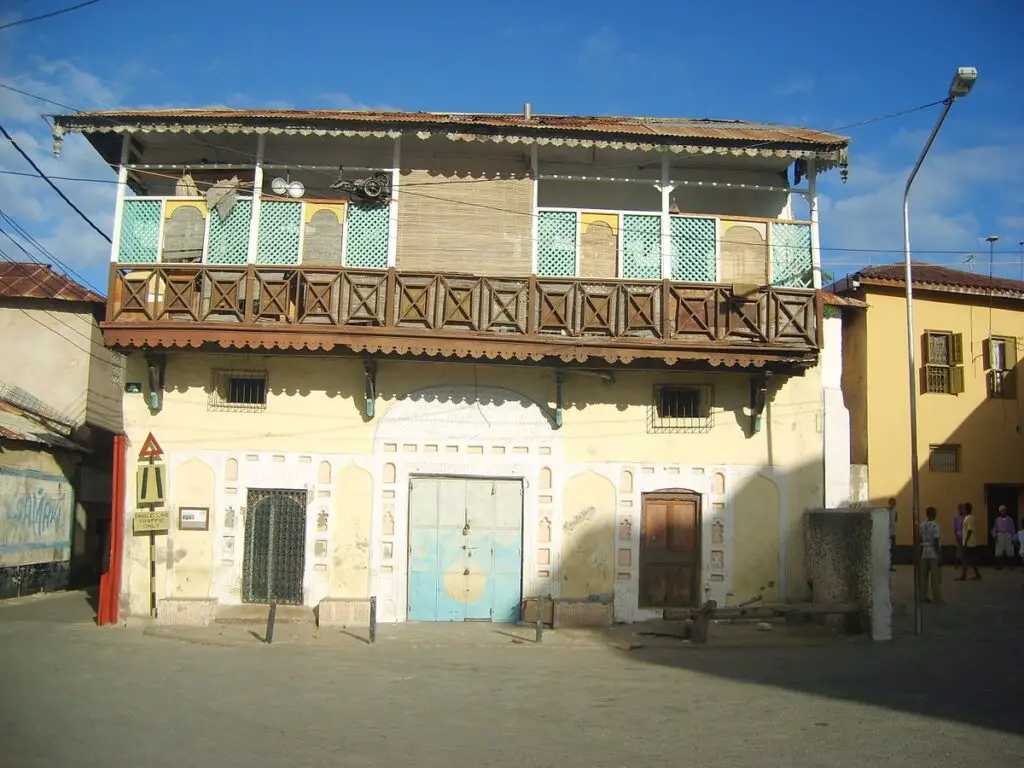
Mombasa’s Old Town is a melting pot of history, culture, and tradition, painting a vivid picture of the city’s vibrant past. Located on the southeastern part of Mombasa Island, the Old Town covers an area of about 72 hectares and is inhabited by a predominantly Muslim population.
The town’s narrow, winding streets are lined with ancient buildings featuring ornate doors and balconies, showcasing a blend of architectural styles influenced by the Portuguese, Arab, and British. These well-preserved buildings date back as far as the 18th century, giving the area a historical charm that attracts both tourists and historians. Some structures in Old Town, such as Mandhry Mosque and the Old Customs House, are listed as national monuments due to their historical and architectural significance.
The Old Town is also a treasure trove of art and culture. The local markets bustle with activity, offering a variety of goods such as spices, antiques, traditional fabrics, and beautifully crafted jewelry. It is here that you can see artisans at work, crafting intricate designs on wood or metal. The scent of local cuisine and fresh seafood fills the air, offering an authentic taste of Swahili culture.
Walking through Old Town Mombasa, you’re likely to hear the hauntingly beautiful call to prayer echoing from the many mosques scattered throughout the area. The mosques, such as the Mandhry Mosque, built in 1570, and the Basheikh Mosque, one of the oldest in Mombasa, are architectural marvels in their own right.
Visiting Old Town gives tourists an intimate look at the life of Mombasa residents and provides a unique opportunity to immerse themselves in the local culture. With its rich history, vibrant atmosphere, and distinctive charm, Mombasa’s Old Town is more than just a tourist attraction; it’s a living, breathing testament to the city’s colorful past.
Mombasa Marine National Park

Mombasa Marine National Park is a marine protected area located in the Indian Ocean, off the coast of Mombasa, Kenya’s second-largest city. Managed by the Kenya Wildlife Service, the park covers approximately 210 square kilometers and is among the most visited marine parks in Kenya.
The park is renowned for its exceptional beauty and rich marine biodiversity. It is home to a variety of marine life, including coral reefs, seagrasses, mangroves, and numerous species of fish. Some of the commonly seen marine creatures include parrotfish, angel fish, butterfly fish, starfish, crabs, sea cucumbers, and sea urchins. The park also houses various types of coral, which form a vibrant underwater landscape.
The Mombasa Marine National Park provides excellent opportunities for water-based activities. Snorkeling is a popular choice among tourists, offering a chance to explore the beautiful coral gardens and observe the fascinating underwater life up close. For more adventurous visitors, the park also offers diving opportunities. Another unique way to view the marine life is by a ride in a glass-bottom boat, providing a window into the colorful underwater world.
In addition to its marine biodiversity, the park is known for its stunning beaches with their soft white sands and crystal-clear waters. North and south of Mombasa, you will find the popular beaches of Nyali, Bamburi, and Shanzu in the north and Shelly, Tiwi, and Diani in the south, all offering stunning views and opportunities for relaxation.
Besides the recreational activities, the park plays a significant role in conservation. It aims to protect the marine environment and its biodiversity from destructive human activities like overfishing and coral harvesting. It also strives to promote sustainable tourism that respects and preserves the marine ecosystem for future generations.
Overall, a visit to Mombasa Marine National Park offers a unique opportunity to immerse oneself in an enchanting marine environment, appreciate nature’s beauty, and learn about the importance of marine conservation.
Haller Park

Haller Park, located in the Bamburi district of Mombasa, Kenya, is an exceptional example of successful environmental reclamation and restoration. Previously a limestone quarry left barren by the extraction activities of the Bamburi Cement company, the area was transformed into a thriving and diverse ecological paradise under the guidance of Dr. Rene Haller, a Swiss naturalist, from whom the park gets its name.
Haller Park spans over 1,000 hectares and is home to a wide variety of plant, bird, and animal species, making it a popular spot for nature lovers. The park has several designated trails that allow visitors to explore the diverse ecosystems, which include forests, ponds, and grasslands.
One of the most iconic inhabitants of Haller Park is its population of Rothschild’s giraffes, a subspecies of the giraffe considered to be at risk of extinction. Visitors can even have the opportunity to feed these majestic creatures during designated feeding times.
The park also hosts a variety of other animals such as hippos, antelopes, waterbucks, buffalos, and monkeys. Bird enthusiasts will be delighted with the over 160 species of birds that have been recorded in the park, including weaver birds, kingfishers, herons, storks, and eagles.
The park is also renowned for its successful crocodile and tortoise breeding programs. Visitors can watch the crocodiles during their feeding times, a sight that is sure to thrill. The giant Aldabra tortoises, some of which are over 100 years old, are another highlight of the park.
Another unique feature of Haller Park is the massive Baobab Adventure, an amusement area that includes climbing frames, swings, and slides, making it a perfect place for families with children.
In addition to its recreational offerings, Haller Park has educational value as well, promoting environmental conservation and sustainable practices. Visitors can learn about the process of ecological restoration and the importance of biodiversity, reinforcing the park’s mission to encourage harmony between humans and nature.
In essence, Haller Park is more than just a wildlife sanctuary. It is a testament to the power of ecological restoration and an educational hub promoting conservation and respect for nature. It offers an incredible opportunity to connect with nature, learn about various species, and witness firsthand the positive impact of environmental conservation.
Mombasa Tusks
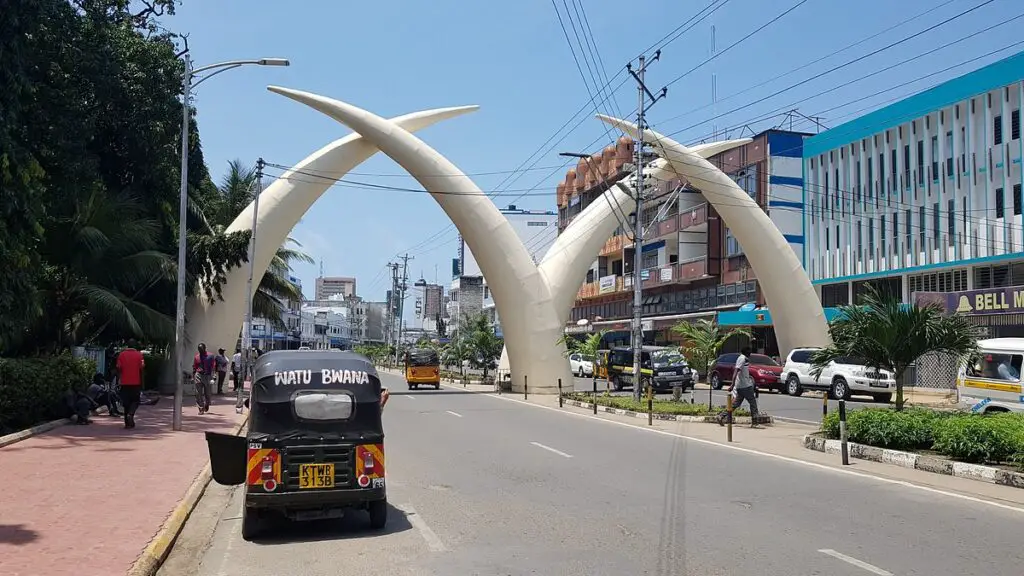
The Mombasa Tusks are an iconic landmark in Mombasa, Kenya’s second-largest city. Erected in 1952, the Tusks were built to commemorate Queen Elizabeth II’s visit to the city. They are located on Moi Avenue, one of the city’s busiest streets, forming an overhead archway that provides a grand welcome to visitors.
The tusks, crafted from aluminum, are shaped to form the letter ‘M’ for Mombasa. They are also symbolic of Kenya’s rich wildlife heritage, specifically its elephants. The use of the tusks as a monument is a nod to the country’s longstanding efforts to conserve its elephant population and its commitment to combating ivory trading. Elephant tusks, which are synonymous with ivory, have been a significant factor in the animal’s endangerment, making the Mombasa Tusks an important symbol of conservation.
Standing at a height of over 15 meters, the Tusks are one of the most photographed landmarks in the city. Their strategic location on a busy thoroughfare makes them an unmissable sight for anyone visiting or passing through Mombasa. At night, they are often illuminated, casting a stunning silhouette against the city’s skyline.
Beyond their symbolic significance and aesthetic appeal, the Mombasa Tusks also mark the entrance to the city’s bustling market area. Here, visitors can explore a wide range of shops and stalls selling everything from traditional Kenyan crafts, jewelry, and clothing to fresh fruits, vegetables, and local delicacies.
In essence, the Mombasa Tusks are more than just a historical monument. They represent Kenya’s commitment to wildlife conservation, the rich cultural heritage of Mombasa, and the city’s welcoming spirit. Whether for a quick photo opportunity or a moment of contemplation on their symbolism, a visit to the Mombasa Tusks is a must for any visitor to the city.
Diani Beach
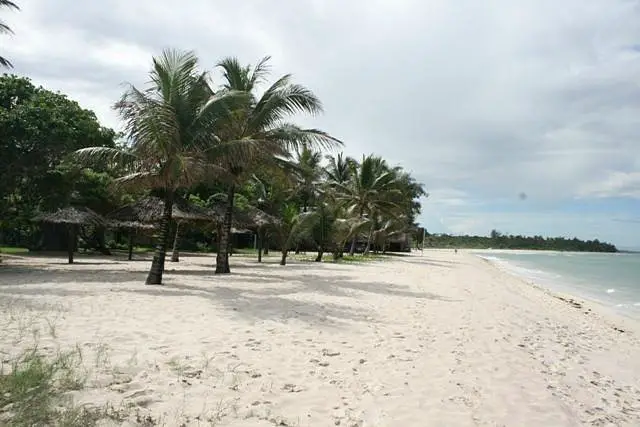
Diani Beach, located 30 kilometers south of Mombasa, is one of Kenya’s premier tourist destinations, known for its stunning natural beauty, balmy weather, and warm, turquoise waters. It stretches over 17 kilometers along the Indian Ocean coast, offering a tranquil paradise away from the hustle and bustle of city life.
The beach is characterized by its soft, white sands fringed by lush green palm trees. The waters are protected by a coral reef, which creates calm, shallow waters near the shore, making it a safe place for swimming. Beyond the reef, the deeper waters are home to an array of marine life, providing excellent opportunities for snorkeling and diving.
Diani Beach is not just for relaxation. It offers a range of activities for adventure seekers. From skydiving to kitesurfing, jet-skiing to dolphin tours, there’s something for everyone. The beach is particularly renowned as a kitesurfing hotspot due to the consistent cross-shore winds.
Bordering the beach are a range of accommodations to suit different budgets and tastes. These include luxury resorts, boutique hotels, and holiday rental villies, many offering stunning ocean views. Diani’s hospitality is warm and welcoming, with staff eager to ensure visitors have an unforgettable stay.
In terms of dining, Diani Beach offers a broad spectrum of options, from fine-dining restaurants serving international cuisine to local beach shacks serving fresh seafood and traditional Swahili dishes. There are also numerous bars and clubs, providing vibrant nightlife.
A short distance from the beach, visitors can explore the Kaya Kinondo Sacred Forest, one of the last sacred forests of the Mijikenda people, offering a cultural experience and a chance to learn about local history and traditions.
Conservation is also a priority in Diani. The Colobus Conservation Center, located nearby, is dedicated to the protection of the endangered Angolan colobus monkey, and visitors can learn about conservation efforts and even spot these unique monkeys in their natural habitat.
In essence, Diani Beach offers the perfect mix of relaxation, adventure, culture, and nature, making it a must-visit destination on the Kenyan coast.
Shimba Hills National Reserve
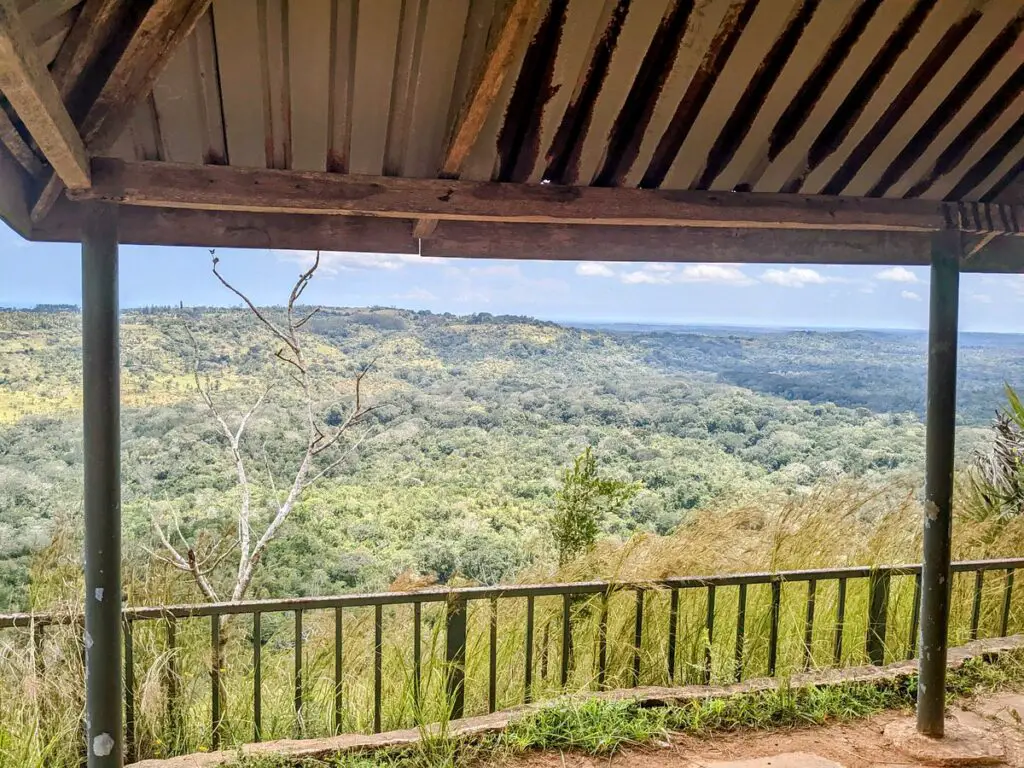
Located just 33 kilometers south of Mombasa, Shimba Hills National Reserve is one of the largest coastal forests in East Africa and a significant area of plant biodiversity. Covering approximately 250 square kilometers, the reserve is an important habitat for a variety of wildlife, and it offers stunning landscapes, including rolling hills, sharp ridges, and verdant valleys.
One of the reserve’s key attractions is its diverse wildlife. Shimba Hills is home to over 100 elephants, the highest density of African elephants in Kenya. It is also the only place in Kenya where you can see the endangered sable antelope, with a population of more than 60 within the reserve.
Besides elephants and sable antelopes, the reserve also hosts other animals such as giraffes, buffalos, leopards, hyenas, and several monkey species. Bird watchers will be pleased to know that over 100 bird species have been identified in the reserve, making it a great spot for bird watching.
The landscape of Shimba Hills National Reserve is characterized by grasslands, woodland, and rainforest, which are crisscrossed by several seasonal rivers. The most famous physical feature within the reserve is the Sheldrick Falls, a spectacular waterfall that cascades down 25 meters into a natural pool, offering a perfect spot for a refreshing swim.
The reserve offers a number of walking safaris and hiking trails that take you through the beautiful forested landscape. There are also several picnic sites and viewing platforms in the reserve, where visitors can take a break and enjoy the panoramic views of the landscape, including the Indian Ocean in the distance.
Within the reserve is the Shimba Hills Lodge, Kenya’s only tree lodge located in a coastal rainforest. The lodge offers an amazing vantage point for watching wildlife at the nearby watering hole and gives you the chance to stay overnight in the reserve.
A visit to Shimba Hills National Reserve provides a unique opportunity to experience the wildlife and natural beauty of the Kenyan coast away from the beach resorts. With its diverse flora and fauna, stunning views, and opportunities for walking and hiking, Shimba Hills is a must-visit for nature lovers and wildlife enthusiasts.
Mamba Village Centre
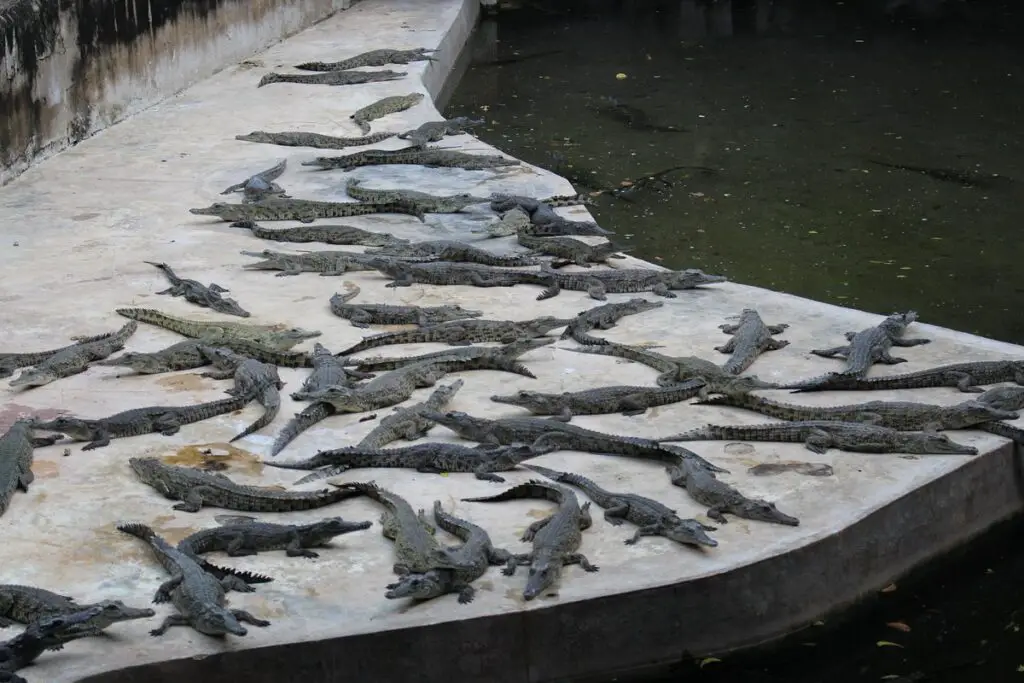
Located in Nyali, Mombasa, the Mamba Village Centre is East Africa’s largest crocodile farm and a popular tourist attraction. The name ‘Mamba’ is Swahili for crocodile, and true to its name, the center is home to over a thousand Nile crocodiles.
Visitors to the Mamba Village Centre can learn a great deal about the life cycle and behavior of crocodiles. The farm is divided into different sections for crocodiles at various stages of growth, from hatchlings to mature adults.
One of the key highlights of a visit is the opportunity to witness feeding time, where the large crocodiles leap high out of the water for their food, a spectacle that is both thrilling and a bit daunting.
Aside from the crocodiles, the centre also hosts other attractions. There’s a horseback riding facility where visitors can enjoy a peaceful ride around the grounds, and a botanical garden featuring an orchard with a variety of fruit trees and an aquatic garden with different species of fish. The center also hosts a butterfly pavilion, where visitors can see a wide variety of colorful and unique butterflies.
For families with young children, the Mamba Village Centre features a playground with swings, slides, and other play equipment. For those looking to relax, the centre has several restaurants and bars where visitors can enjoy a meal or a drink.
The Mamba Village Centre is not just about fun and entertainment. It also has an educational role, offering visitors a chance to learn about crocodile conservation and the importance of preserving biodiversity. This combination of education and entertainment makes a visit to the Mamba Village Centre a fun, informative, and unique experience for visitors of all ages.
Mombasa Go Cart
For those seeking an adrenaline-filled experience in Mombasa, the Mombasa Go-Kart is a must-visit attraction. Located in the Bamburi area, Mombasa Go-Kart offers an exciting go-karting experience suitable for both kids and adults.
The track is professionally designed, providing a safe and thrilling racing environment. It includes a variety of straights, curves, and challenging twists to test your driving skills. Whether you’re a novice or an experienced kart driver, Mombasa Go-Kart provides an exhilarating and competitive racing experience.
The go-karts themselves are well-maintained and come in different sizes to accommodate drivers of all ages. Children can ride in smaller, slower karts, while adults can opt for faster, more powerful karts. Safety is a priority at Mombasa Go-Kart, and all drivers are provided with helmets and a brief safety orientation before hitting the track.
But the fun at Mombasa Go-Kart doesn’t stop with the racing. The center also features a variety of other activities, including a billiards table, a bounce castle for the younger children, and a video game arcade. There’s also a restaurant on-site that serves a variety of local and international cuisines, as well as a bar where adults can enjoy a refreshing drink.
One of the unique features of Mombasa Go-Kart is their “Arrive and Drive” system. This means you don’t need to make a booking in advance – you can simply show up, choose your kart, and start racing. This makes it a convenient option for a spontaneous day out.
In summary, Mombasa Go-Kart offers an exciting day out for families, groups of friends, or even solo visitors. It’s a place where you can test your racing skills, enjoy some friendly competition, and have a lot of fun in the process.

